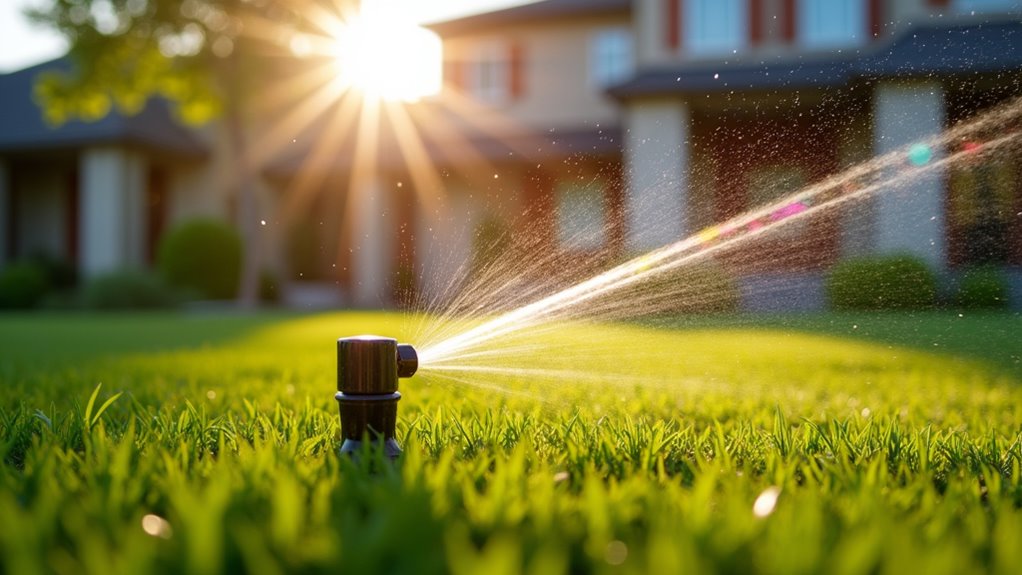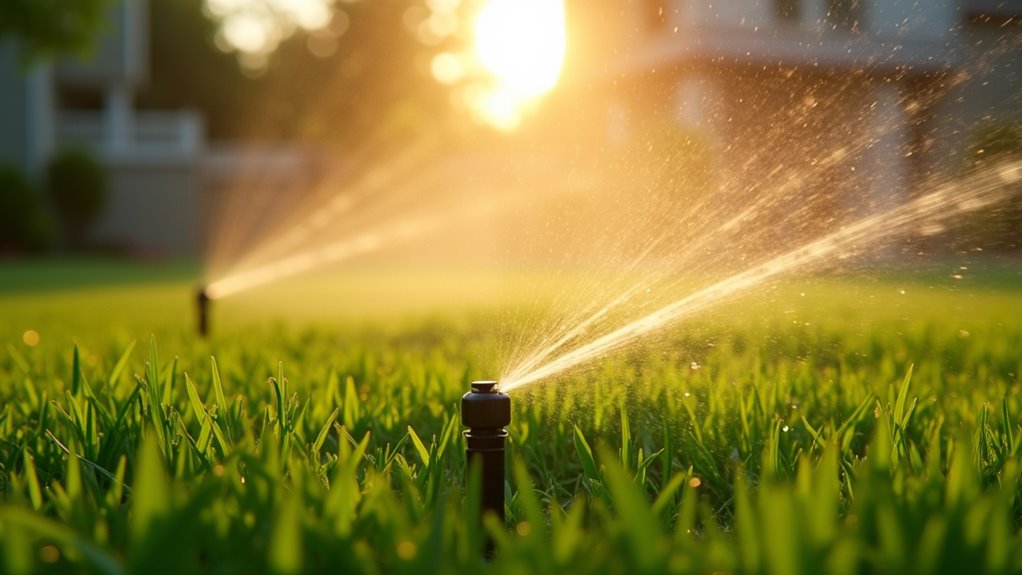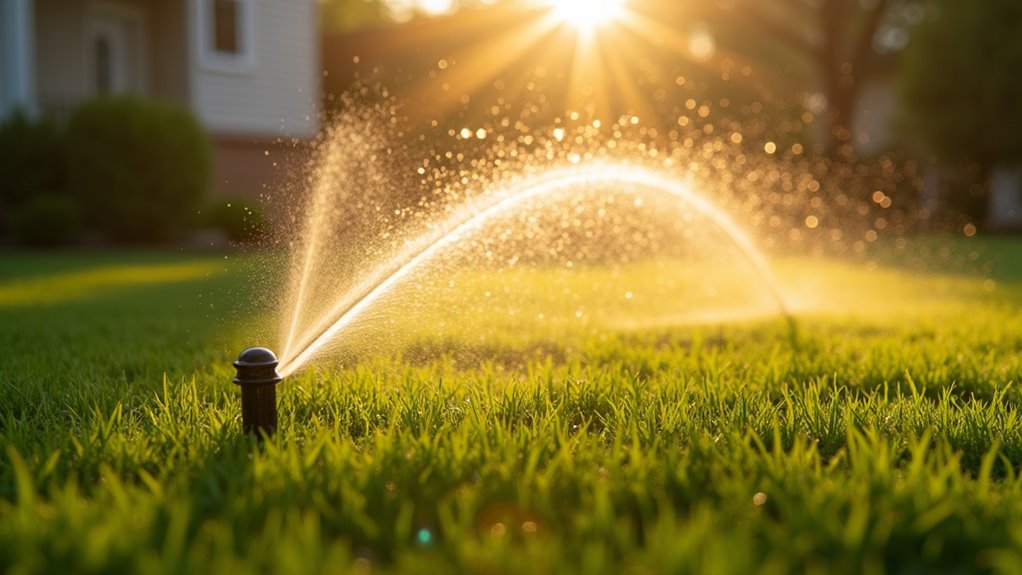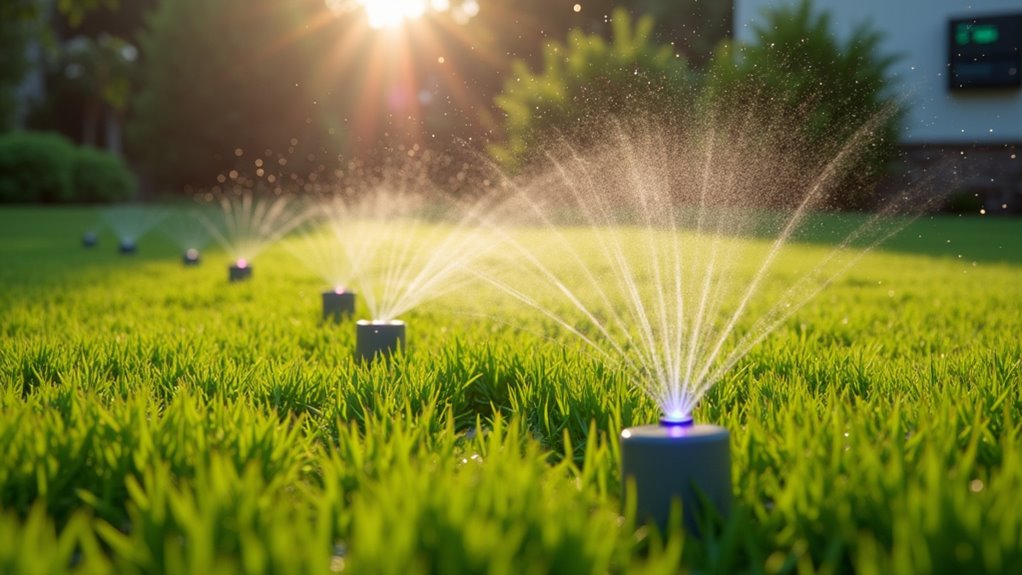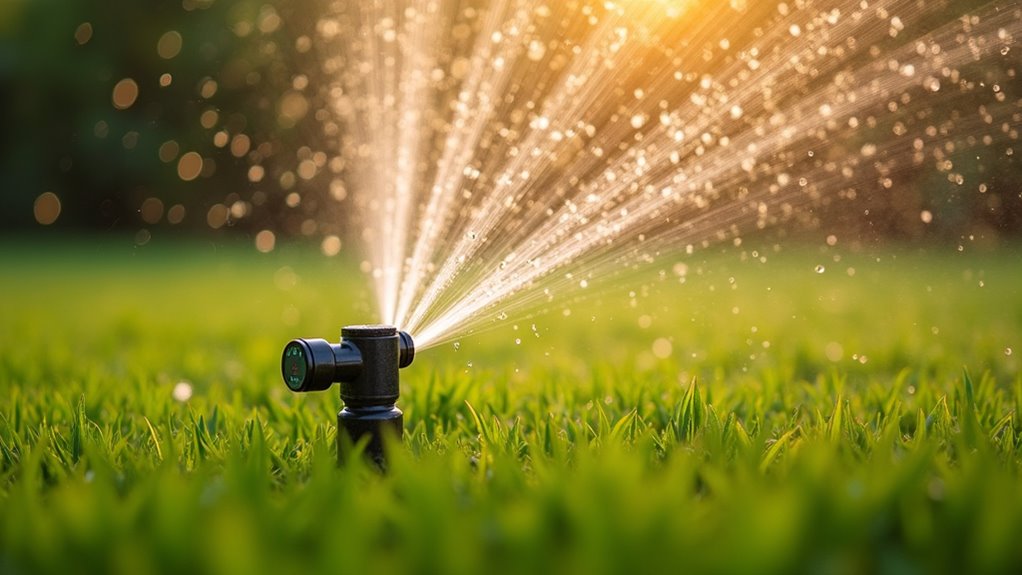Most lawns require deep, infrequent irrigation of 1-1.5 inches water every 2-3 days rather than daily shallow watering. You’ll need to adjust based on your soil type: sandy soils need more frequent watering (every 3-4 days), while clay soils retain moisture longer (every 7-10 days). Morning irrigation (5:00-9:00 AM) optimizes water utilization and minimizes fungal disease risk. Your lawn’s visual cues—folded blades, footprint persistence—signal when hydration intervention becomes necessary.
 While many homeowners apply a one-size-fits-all approach to lawn irrigation, your turfgrass ecosystem requires a nuanced hydration regimen based on multiple biotic and abiotic factors. Soil composition greatly influences lawn moisture retention—clay soils hold water longer than sandy substrates, necessitating adjusted irrigation frequencies.
Your grass species exhibits distinct hydrophilic requirements; cool-season varieties (Festuca, Poa) demand different moisture levels than warm-season cultivars (Cynodon, Zoysia). Environmental variables—solar radiation, precipitation patterns, and evapotranspiration rates—further modify these needs.
Efficient irrigation techniques include deep, infrequent watering to promote extensive root development rather than shallow, frequent application. Monitor soil moisture at root depth (4-6 inches) using a soil probe or moisture meter to optimize your watering schedule and prevent both drought stress and fungal proliferation from excess hydration.
While many homeowners apply a one-size-fits-all approach to lawn irrigation, your turfgrass ecosystem requires a nuanced hydration regimen based on multiple biotic and abiotic factors. Soil composition greatly influences lawn moisture retention—clay soils hold water longer than sandy substrates, necessitating adjusted irrigation frequencies.
Your grass species exhibits distinct hydrophilic requirements; cool-season varieties (Festuca, Poa) demand different moisture levels than warm-season cultivars (Cynodon, Zoysia). Environmental variables—solar radiation, precipitation patterns, and evapotranspiration rates—further modify these needs.
Efficient irrigation techniques include deep, infrequent watering to promote extensive root development rather than shallow, frequent application. Monitor soil moisture at root depth (4-6 inches) using a soil probe or moisture meter to optimize your watering schedule and prevent both drought stress and fungal proliferation from excess hydration.
 Regional climate variants fundamentally alter your lawn’s hydration requirements, with precipitation patterns and evapotranspiration rates serving as primary determinants. In arid desert ecosystems, you’ll need to compensate for extreme water loss through more frequent irrigation cycles, while humid coastal microclimates may require less supplemental hydration due to atmospheric moisture retention. Your irrigation schedule should adapt to seasonal fluctuations in temperature, precipitation, and day length that directly impact your turfgrass’s metabolic processes and water utilization efficiency.
Regional climate variants fundamentally alter your lawn’s hydration requirements, with precipitation patterns and evapotranspiration rates serving as primary determinants. In arid desert ecosystems, you’ll need to compensate for extreme water loss through more frequent irrigation cycles, while humid coastal microclimates may require less supplemental hydration due to atmospheric moisture retention. Your irrigation schedule should adapt to seasonal fluctuations in temperature, precipitation, and day length that directly impact your turfgrass’s metabolic processes and water utilization efficiency.
 Different turfgrass species exhibit remarkable variation in their hydrological requirements, a critical factor you’ll need to contemplate for ideal lawn management. Fescue varieties, particularly tall fescue (Festuca arundinacea), demonstrate superior drought resistance with root systems extending 2-3 feet deep, requiring irrigation only when soil moisture depletes below 50% field capacity.
Conversely, Kentucky bluegrass (Poa pratensis) demands more frequent hydration interventions, typically requiring 1-1.5 inches weekly during growing seasons. You’ll observe this species entering dormancy when precipitation is insufficient. Bermudagrass (Cynodon dactylon) thrives in xeric conditions, while St. Augustine (Stenotaphrum secundatum) exhibits higher transpiration rates.
For ecological water conservation, select species adapted to your regional precipitation patterns rather than modifying your irrigation regime to accommodate non-native cultivars with excessive hydrological demands.
Different turfgrass species exhibit remarkable variation in their hydrological requirements, a critical factor you’ll need to contemplate for ideal lawn management. Fescue varieties, particularly tall fescue (Festuca arundinacea), demonstrate superior drought resistance with root systems extending 2-3 feet deep, requiring irrigation only when soil moisture depletes below 50% field capacity.
Conversely, Kentucky bluegrass (Poa pratensis) demands more frequent hydration interventions, typically requiring 1-1.5 inches weekly during growing seasons. You’ll observe this species entering dormancy when precipitation is insufficient. Bermudagrass (Cynodon dactylon) thrives in xeric conditions, while St. Augustine (Stenotaphrum secundatum) exhibits higher transpiration rates.
For ecological water conservation, select species adapted to your regional precipitation patterns rather than modifying your irrigation regime to accommodate non-native cultivars with excessive hydrological demands.
Understanding Your Lawn’s Watering Needs

Signs of Underwatering vs. Overwatering
Recognizing the distinction between foliar wilt patterns can help you identify whether your turf grass suffers from insufficient or excessive moisture levels. You’ll observe footprints remaining visible and leaf blades folding inward during drought stress, while fungal colonization and chlorosis often indicate saturated soil conditions. Testing soil moisture at root depth (approximately 6-8 inches) provides quantitative confirmation of your visual assessment and informs appropriate irrigation adjustments for ideal plant physiological functioning.Visual Lawn Indicators
The visual cues your lawn exhibits serve as its communication system, alerting you to hydration imbalances before permanent damage occurs. Observe your turf’s physical appearance daily, noting color variations and structural changes in the leaf blades. Underwatered lawns display folded or rolled leaf blades conserving moisture, with a gray-blue hue replacing vibrant green. Footprints persist as compressed grass lacks cellular turgor pressure needed for resilience. Conversely, overwatered turf develops fungal colonies visible as circular patches, while excessive thatch accumulation and algal growth indicate prolonged saturation. You’ll notice stunted root development in both scenarios, though underwatering produces brittle, shallow systems while overwatering creates waterlogged, oxygen-deprived roots susceptible to rot. These lawn appearance indicators offer critical intervention windows when properly interpreted within your specific microclimate and soil composition context.Water Stress Symptoms
Lawn grasses exhibit distinctive physiological responses when experiencing hydrological stress, creating identifiable symptom patterns that differentiate between deficit and surplus water conditions. When your turfgrass undergoes water deficit stress, you’ll observe foliar wilting, footprint persistence (where compressed blades don’t recover), and bluish-gray discoloration as cellular turgor pressure diminishes. The leaf blades fold longitudinally to reduce transpiration surface area—an adaptive drought response mechanism. Conversely, excess hydration manifests through fungal proliferation (often appearing as mycelia networks or fruiting bodies), chlorosis (yellowing), and spongy substrate conditions. You’ll notice thatch accumulation accelerates while root development becomes shallow and limited. These symptoms indicate reduced oxygen availability in the rhizosphere, leading to compromised nutrient uptake efficiency and metabolic dysfunction within plant tissues.Soil Condition Tests
While visual assessment of turfgrass provides initial diagnostic indicators, definitive determination of soil moisture status requires systematic edaphic evaluation through tactile and instrumental methodologies. You’ll need to employ both manual and quantitative techniques to ascertain ideal hydration parameters. Extract a soil core (15cm depth) from your lawn’s representative zones using a soil probe. Evaluate soil moisture by compressing a sample within your palm—ideally hydrated soil forms a cohesive mass without expelling water. For scientific precision, utilize a soil moisture meter with numeric outputs indicating hydric sufficiency. Additionally, conduct periodic pH testing as irrigation practices influence soil chemistry. Properly hydrated lawns maintain pH stability, whereas overwatering induces leaching of essential nutrients and acidification. Underwatered soils often exhibit alkaline conditions through concentration of mineral compounds, impeding nutrient bioavailability for turfgrass systems.Best Watering Practices by Season
Your turfgrass ecosystem requires season-specific hydration protocols to optimize photosynthetic capacity and soil microbiome health. In spring, you’ll need to gradually increase irrigation frequency as dormant grass shifts to active growth, while summer demands strategic deep watering to encourage drought-resistant root development. Fall irrigation practices should taper gradually, allowing your lawn to harden off as you prepare the root zone for winter dormancy with a final, thorough hydration before the initial frost.Spring Revival Techniques
Three critical factors converge during spring that necessitate specialized irrigation protocols for ideal turfgrass rejuvenation. As soil temperatures rise and dormant grass shifts to active growth phases, your spring lawn care regimen must adapt accordingly. During this critical recovery period, the root system requires consistent hydration to facilitate cellular elongation and nutrient uptake.- Apply 1-1.5 cm of water biweekly during early spring, gradually increasing to 2-3 cm as ambient temperatures rise
- Water between 0400-0700 hours to minimize evapotranspiration while maximizing root zone absorption
- Implement deficit irrigation techniques on established lawns to promote deeper rhizosphere development
Summer Drought Defense
As temperatures spike during summer months, turfgrass experiences heightened evapotranspiration rates that can deplete soil moisture reserves within 24-48 hours. You’ll need to implement strategic irrigation protocols during this critical period, applying 1-1.5 inches of water per week, ideally between 4:00-6:00 AM to minimize fungal pathogen proliferation. Consider shifting to drought resistant grasses like Bermuda or Zoysia that maintain aesthetic appeal while requiring 30-40% less hydration than conventional cultivars. Incorporating hydrophilic polymers into your soil matrix can improve moisture retention capacity by up to 50%, reducing irrigation frequency without compromising cellular turgidity. Furthermore, maintaining grass height at 3-3.5 inches creates beneficial shade for root zones, decreasing soil temperature fluctuations and conserving subsurface water reserves during extended thermal stress periods.Fall Winterizing Methods
While summer requires vigilant hydration protocols, autumn necessitates a shift in irrigation strategy to properly prepare turfgrass for dormancy periods. Your fall lawn care regimen should gradually reduce watering frequency as temperatures decline, allowing root systems to harden off before winter’s freeze-thaw cycles. Apply water deeply but infrequently—approximately 1 inch biweekly—until the initial frost approaches. For ideal winter lawn preparation:- Perform a deep watering 24-48 hours before predicted initial frost to hydrate root zones without saturating crown tissues
- Reduce irrigation volumes by 30-50% during leaf senescence to promote carbohydrate storage in rhizomes
- Terminate all irrigation when soil temperatures consistently register below 40°F (4.4°C)
Morning vs. Evening: Optimal Watering Times
When should you irrigate your lawn for maximum hydration efficiency? Turfgrass hydration timing greatly impacts physiological processes and water conservation efforts. Morning benefits (5:00-9:00 AM) include reduced evapotranspiration rates as solar radiation remains minimal while allowing adequate foliar absorption. This timing optimizes water utilization by the root zone while minimizing fungal pathogen development. The photosynthetic machinery can immediately utilize available moisture during peak metabolic activity periods. Evening irrigation introduces considerable drawbacks to your lawn’s microecosystem. Prolonged leaf wetness during nocturnal hours creates ideal conditions for fungal proliferation, particularly Rhizoctonia solani and Pythium species. Furthermore, evening watering increases gastropod activity and reduces water-use efficiency due to greater vapor pressure deficit conditions. For ecological and physiological optimization, morning irrigation represents the scientifically superior approach for sustainable turfgrass management.Regional Climate Considerations for Lawn Irrigation

Arid Desert Regions
Despite their challenging conditions, arid desert regions present unique lawn irrigation requirements that demand careful water management strategies. You’ll need to adopt xeriscaping principles and deep watering techniques to maintain turfgrass in these environments. Bermudagrass (Cynodon dactylon) and buffalograss (Bouteloua dactyloides) demonstrate superior drought tolerance in desert ecosystems. For best water conservation while maintaining lawn health:- Water during predawn hours (3-5 AM) to minimize evaporation rates and enhance stomatal absorption efficiency
- Implement deficit irrigation protocols at 60-70% evapotranspiration rates to promote deeper root development
- Integrate desert landscaping buffer zones with drought resistant plants like Agave species and Larrea tridentata
Humid Coastal Areas
Coastal regions with heightened humidity levels create distinctive microenvironments that markedly influence turfgrass irrigation requirements and management protocols. You’ll find these areas necessitate a modified approach to lawn hydration due to their unique atmospheric conditions. In humid coastal zones, you’ll need to water less frequently—typically once every 7-10 days—as ambient moisture supplements soil hydration. Your lawn’s transpiration rates decrease when humidity exceeds 60%, reducing water loss. Consider salt tolerance when selecting grass varieties; Paspalum and Zoysia cultivars demonstrate superior halophytic adaptations to coastal conditions. Monitor soil moisture rather than following rigid schedules, as maritime air currents can create microclimatic variations. Morning irrigation (5-7 AM) optimizes humidity effects while minimizing fungal pathogen proliferation. Deep, infrequent watering encourages strong root development while conserving this vital resource.Seasonal Weather Patterns
Seasonal meteorological fluctuations across different biogeographical zones greatly impact turfgrass water requirements throughout the calendar year. You’ll need to adapt your irrigation protocols to accommodate these seasonal variations. During precipitation-abundant periods, reduce supplemental hydration frequency to prevent soil saturation and potential root hypoxia. Weather impacts necessitate dynamic irrigation scheduling:- Spring: Implement gradual increases in watering frequency as temperatures rise, coinciding with improved photosynthetic activity and root development
- Summer: During peak evapotranspiration periods, increase watering depth while maintaining proper intervals between irrigation events
- Autumn: Gradually reduce watering frequency while maintaining adequate soil moisture for root system fortification prior to dormancy
Grass Species and Their Water Requirements

Soil Type and How It Affects Watering Frequency
While grass species selection establishes baseline irrigation requirements, the soil’s physical composition fundamentally determines water infiltration, retention, and availability rates within your lawn’s rhizosphere. You’ll need to adapt your irrigation protocol based on your property’s specific edaphic conditions.- Sandy soils exhibit high drainage capacity but poor soil moisture retention, necessitating more frequent, shorter watering cycles (typically 3-4 times weekly).
- Clay soils display opposite characteristics—excellent moisture retention but poor infiltration rates—requiring less frequent but deeper irrigation events (every 7-10 days).
- Loam soils represent the ideal matrix, balancing both drainage and retention properties, allowing for moderate watering schedules (every 5-7 days).
Water-Saving Technologies for Smart Lawn Care
Modern irrigation technology has revolutionized residential lawn hydration management, offering homeowners precision tools that improve water application while minimizing waste. You’ll find that drip irrigation systems deliver water directly to the root zone, reducing evaporation by up to 70% compared to traditional sprinklers. These systems maintain soil moisture at ideal levels while conserving our planet’s most precious resource. Moisture sensors provide real-time data on soil hydration status, automatically adjusting irrigation schedules based on actual need rather than predetermined timing. When integrated with smart controllers, these devices analyze local evapotranspiration rates and precipitation forecasts to create dynamic watering regimens. You’ll greatly reduce your ecological footprint while maintaining turfgrass health by implementing these technologies. The initial investment in such systems typically yields returns through reduced water bills and improved turf longevity.Establishing Watering Routines for New Sod vs. Established Lawns
Newly installed sod and established turfgrass demand fundamentally different hydrological regimens to optimize root development and general health. During sod establishment, you’ll need to maintain consistent soil moisture to facilitate rhizosphere colonization and prevent desiccation. Initially, water 2-3 times daily with short durations to keep the upper soil profile saturated. As lawn maturity progresses, shift to these evidence-based practices:- Reduce irrigation frequency to 2-3 times weekly while increasing duration to encourage deeper root penetration
- Implement dawn watering (4:00-6:00 AM) to minimize evapotranspiration losses and fungal pathogen proliferation
- Adjust seasonal application rates: 1.5-2 inches weekly during active growth periods, reduced to 0.5-1 inch during dormancy

